An Ordinary of Hateful Heraldry Vuong Manh Read
In heraldry, an ordinary (or honourable ordinary) is a elementary geometrical figure, bounded by straight lines and running from side to side or pinnacle to bottom of the shield. At that place are as well some geometric charges known as subordinaries, which accept been given lesser status by some heraldic writers, though most have been in use as long as the traditional ordinaries. Diminutives of ordinaries and some subordinaries are charges of the same shape, though thinner. Near of the ordinaries are theoretically said to occupy i-third of the shield; only this is rarely observed in practise, except when the ordinary is the only charge (as in the glaze of arms of Republic of austria).
The terms ordinary and subordinary are somewhat controversial, as they have been practical arbitrarily and inconsistently among authors, and the utilise of these terms has been disparaged past some leading heraldic authorities.[1] In his Complete Guide to Heraldry (1909), Arthur Charles Play a joke on-Davies asserted that the terms are likely inventions of heraldic writers and not of heralds,[two] arguing the "utter absurdity of the necessity for any [such] classification at all," and stating that the ordinaries and sub-ordinaries are, in his mind, "no more than first charges."[iii]
Ordinaries [edit]

Ordinaries (sometimes called "honourable ordinaries") resemble partitions of the field, but are formally considered objects on the field. Though in that location is some debate equally to exactly which geometrical charges—with direct edges and running from edge to edge of the shield—constitute ordinaries, sure ones are agreed on by everyone. Except for the chief they are central to the shield.
- Cross: a pale and a fess of equal widths conjoined (though the cantankerous is typically thinner than this would propose), as in the artillery of the City of London.
- Pale: a vertical stripe right down the middle of the shield. Typically 1⁄v to 1⁄3 the width of the field.
- A variant is the Canadian pale, invented in 1964 for the new Canadian national flag: it takes upwardly one-half the width of the field.
- Fess: a horizontal stripe, as in the glaze of artillery of Republic of austria. Typically one⁄v to 1⁄3 the height of the field.
- Bar: a narrower fess (said in theory to occupy one-fifth of the field), sometimes reckoned as an ordinary in its ain right. It is rarely borne singly.
- Bend: an oblique band from the dexter chief (the bearer's upper right, viewer's upper left) to the contrary corner, as in the arms of the sometime grand duchy of Baden.
- Bend sinister: a bend in the opposite direction (sinister chief to dexter base).
- Chevron: two diagonal bands meeting in the center in the form of an inverted V, or like the beams of a gable; as in the arms of Udine, Italian republic, or Trans, Switzerland.
- Saltire: a bend and a bend sinister both of equal widths conjoined to grade a diagonal cross (×), every bit in the Scots national imprint (frequently referred to just as "the Saltire"), and also known colloquially every bit a St Andrew's cross.
- Chief: a horizontal band right across the top of the shield, as in the artillery of the district of Lausanne (Vaud, Switzerland).
- Principal triangular begins in the corners and extends to a indicate that is ane quarter to i third the fashion downward the shield. It is a complex line sectionalization variant of a chief.
- Chief enarched is drawn with a concave arch.
- Chief double-biconvex has two concavities.
- Terrace in base (French: champagne, terrace; Italian campagna; High german Schildfuß)
- Mount when represented in light-green and curved or biconvex, every bit a colina.
- Mount mounted, or Shapournet shapourned: a Trimount.[4]
The following are sometimes classed as ordinaries, sometimes as subordinaries (see below):[5]
- Bordure: the boundary of the shield; often used for cadency.
- Pile: down pointing triangle, issuing from the pinnacle of the shield.
- Drape or Pairle: a Y-shape.
- A variant is the shakefork: a drapery cut short of the margins, with pointed ends. It is frequent in Scotland, owing to its prominence in the armoury of Clan Cunningham.
-
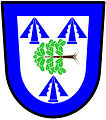
a bordure—Argent; an oak tree eradicated, fessways, proper, between iii pheons, points upwardly, azure; inside a bordure azure—Dalgleish of Keavil, Scotland
-
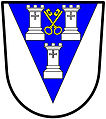
a pile—Argent, on a pile azure three towers, two and one, of the first, in the middle master bespeak two keys in saltire, wards upwards and inward, or—Otley Urban District Council, England
-
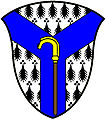
a pairle or pall—Ermine; a pairle azure charged with the crosier of St Fillan proper—Dewar, Canada* (Scots coat)
-

a shakefork—Azure, a shakefork argent supporting in the middle main a bezant, within an annulet enwreathed, ensigned of a naval crown or, the sails argent, below which on a panel argent edged or is the proper name 'Discovery' in messages sable—HM Canadian Send Discovery
Lines of variation [edit]
Ordinaries demand not be divisional by directly lines.
-

engrailed—Sable, a cross engrailed silvery
-
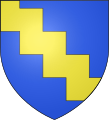
dancetty—Azure, a bend dancetty or
-

wavy—Vert, three bars wavy silver
-

fir-twigged and wavy—Or, a bend upper edge fir twigged, lower edge wavy, vert
Subordinaries [edit]
Some geometric figures are not considered to be "honourable ordinaries" and are called "subordinaries". Very loosely, they are geometric or conventional charges that, different ordinaries, do not stretch from edge to border of the shield. At that place is no definitive listing or definition, but they mostly include:
Fixed subordinaries [edit]
Stock-still subordinaries are those that take a particular place to keep a shield—or at to the lowest degree a very limited range of places.
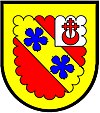
a county—Gules; on a bend or two cinquefoils azure, on a sinister canton argent a cantankerous crosslet fitchy issuing out of a crescent of the outset; a bordure engrailed or for deviation—Cook, Scotland
- Quarter: the dexter master quadrant of the shield
- Canton: smaller than the quarter, formally said to occupy one-ninth of the shield, though sometimes fatigued smaller. The canton is often said to exist the quarter's atomic, but perhaps information technology should be treated equally a subordinary in its own right as it fulfils heraldic functions non fulfilled by the quarter, and behaves according to its own special rules—equally for example in the case of the canton on which baronets in the UK may brandish the badges of their 'rank', which is very rarely shown occupying such a large area as the upper left third of the field, and is unremarkably much less and very oftentimes shown non equally square only as a rectangle with its longer side vertical. Very occasionally a 'sinister canton' is constitute, on the shield's other side.
- Flaunches, e'er borne in pairs: a circular arc emerging out of each flank of the shield.
- Fret: interlacing bendlet, bendlet sinister and mascle.
- Gore: 2 arcs meeting in the fess point to grade a triangular segment.
- Gyron: the lower half of a quarter cut diagonally, said to be an old charge only rare although there are modern examples (e. g. de Cluseau)
- Orle: A bordure separated from the exterior of the shield. Similar the bordure the orle takes on the shape of the shield or flag it is on. Although the orle'south atomic is the tressure, at that place are examples of "fillet orles" (orles narrower than usual). Information technology is often said that an orle may not have other charges charged on it, simply the Scots Public Register. When a number of charges are arranged every bit if on a bordure, they are said to be in orle or to class an orle of such charges.
- Tressure: a thinner version and hence atomic of the orle. The well-nigh famous tressure is probably the double tressure flory counter flory in the royal glaze of arms of Scotland. Tressures with other ornament exist, such as with maple leaves, crescents, thistles and roses.
-

a quarter—Argent, a quarter gules
-

a canton—Silverish, a county gules
-

flaunches—Argent, flaunches gules
-

a fret—Silverish, a fret gules. Arms of the Blake family.
-

an orle—Silverish, an orle azure (D'silver à l'orle d'azur—Lacroisille, Tarn, France)
-

a gore—Silver, a gore gules
-

a gyron—Vert five barrulets dovetailed on the lower sides Silvery, in dexter base a gyron voided of the field in sinister chief a crescent over all at centre point the sun in his splendour all Or.—Green, Scotland
-

an orle charged—Parted per pale argent and sable; an orle engrailed on both sides charged with four quatrefoils within a bordure, all counter changed—Norie, Scotland
-

an orle of crescents and mullets—Sable; a cross moline inside an orle of crescents and mullets alternately, argent—Sibbald, Scotland
-

a tressure—Azure, an annulet, therewithin three barrulets wavy, conjoined, all within a tressure, argent—Umgeni Water Board, RSA
-

a double tressure—Azure; a facetted six pointed star [mullet] argent ensigned with a gable crown or, the whole within a double tressure argent—Langenhoven, RSA
Mobile subordinaries [edit]
Other subordinaries can be placed anywhere on the field.
- Escutcheon: a shield used as a charge.
-

an escutcheon— Or, an escutcheon sable—Bourigeole, Aude, France
-
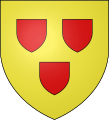
3 escutcheons— Or, iii escutcheons gules—d'Abbeville, France
-

3 escutcheons — Argent; three escutcheons gules; within a bordure chequy gules and silverish—Hay of Pitfour, Scotland
-

escutcheon en surtout—Arms of Murray, Duke of Atholl, Scotland includes an escutcheon en surtout for the Chiefship of the Proper name of Murray and with the crown of a marquess for the Marquessate of Tullibardine
-
- escutcheon of pretence or en surtout—When one escutcheon is borne in the centre of the coat, information technology is sometimes called an inescutcheon or an escutcheon of pretence or an escutcheon en surtout. Such centrally placed escutcheons usually have some particular significance. For instance, in artillery of dominion an inescutcheon typically shows the dynastic arms of the prince, whose possessions are shown in the quarters of the main shield; current examples include the arms of the Danish Royal Family unit, with an inescutcheon of the house of Oldenburg, and the glaze of arms of Espana, with an inescutcheon of the house of Bourbon-Anjou. In Scots heraldry the escutcheon en surtout serves several different purposes. This all comes under the heading of marshalling.
- Lozenge: a rhomb with its long axis upright, resembling the diamond of playing-cards.
-
- Fusil: a thin lozenge; very much taller than it is broad.
- Mascle: a voided lozenge (i.e. with a largish lozenge shaped hole)
- Rustre (very rare): a lozenge pierced (i.due east. with a smallish round hole)
-

3 lozenges—Gules, 3 lozenges argent— Guillaume de Haer (according to Gelre)
-

3 fusils—Per fess azure and vair ancient; iii fusils in principal and a crescent in base, or; a bordure engrailed silver—Freeman of Murtle, Scotland
-
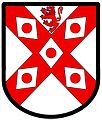
5 rustres—Argent; on a saltire gules five rustres argent, in chief a lion rampant of the 2d (gules)—Dalrymple of Woodhead, Scotland
- Roundel: a disc or ball, as in the arms of the Duchy of Cornwall or of the Medici. In the Anglophone heraldries differently coloured roundels have different names, e.thou. a roundel or is called a bezant and a roundel azure is called a hurt. French heraldry solely distinguishes besants (roundels of a metal tincture) and tourteaux (roundels of a colour tincture): hence, the Canadian Francophone versions of blazons follow suit — Anglophone hurt is Francophone tourteau d'azur, and Anglophone bezant is a besant d'or
-
- Annulet: a voided roundel (i.e. with a largish round hole, resembling a ring)
-

a injure (roundel azure)—Or, a hurt; D'or au tourteau d'azur—Launaguet, Haute-Garonne, France
-
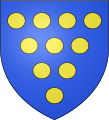
x bezants (roundels or)—Azure, ten bezants in pile; D'azur à dix besants d'or posés four, iii, 2, 1— Jean IV de Rieux, France
-

three annulets—Gules, three annulets in pile silvery; De gueules à trois annulets d'silver posés ii, 1— Mâcon, France
- Barracks: a small rectangle, resembling a brick or a alphabetic character. Billets are ordinarily vertical (as in the arms of the Kingdom of the netherlands), simply tin be horizontal (every bit in the arms of Friesland).
-

xi billets—Azure, eleven billets or; D'azur à onze billettes d'or posés 4, four, 3— Donzy, Nièvre, France
Diminutives [edit]
When a coat of artillery contains ii or more of an ordinary, they are almost ever blazoned (in English) equally diminutives of the ordinary, as follows.
Diminutives of the pale [edit]
- pallet: theoretically half the width of a pale.
- endorse: half the width of a pallet; as well found in pairs on either side of a stake when the term "endorsed" is used
-

iii pallets—Per fess or and azure; in chief a dexter arm vambraced and a sinister arm contourny vambraced, proper and in base iii pallets argent—Armstrong, U.s.a. (Scots arms)
-
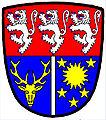
an endorse—Per fess gules and azure; in chief three lions rampant, argent, in base an endorse silverish betwixt, dexter, a stag'due south caput cabossed, and, sinister, a dominicus in its splendour, between five mullets, or—Ross and Cromarty Commune Council, `Scotland
-

pale endorsed—Sable; a pale chequy argent and azure of 24 pieces, endorsed argent; on a chief or five flames gules—Secunda Wellness Committee, RSA
Diminutives of the fess [edit]
- bar, run into to a higher place.
- barrulet, narrower than both.
- hamade (too called hamaide or hummet): a bar couped which doesn't reach the edges of the shield, usually in threes
-

3 bars—Per bend sable and azure; three bars or—Kenan, Scotland
-

5 barrulets—Argent; five barrulets sable, engrailed on their under edges, the effigy of St Peter enhaloed, proper, vested azure and or, in his dexter hand two keys in saltire or and silver—Burgh of Thurso, Scotland
-

3 hamades—Silverish, three hamades gules
Diminutives of the curve [edit]
- bendlet, half the width of a bend.
- ribbon or riband, half the width of a bendlet, occasionally called a cost
- baton: a bendlet couped which doesn't accomplish the edges of the shield, oft said to be but a bendlet sinister couped, merely has certainly been used equally a couped bendlet 'dexter' since the 17th century at the latest
-

a bendlet—Vert; a bendlet wavy silvery between six billets gules, each fimbriated or—Stroud Urban District Council, England
-

a ribbon (or riband)—Or, lion rampant gules, surmounted of a ribbon sable; within a bordure azure charged with three boars' heads erased, or—Drummond of Hawthornden, Scotland
-

a billy—Gules; on a bend engrailed or a baton azure; within a bordure vair—Elliot, Scotland (matriculated 1693)
Diminutive of the bend sinister [edit]
- bendlet sinister, half the width of a curve sinister, also very occasionally called a scarpe;
- baton sinister, a bendlet sinister couped
-

a bendlet sinister—Argent, a bendlet wavy azure and a bendlet sinister wavy vert, over all on a cross gules five roses argent barbed and seeded proper—North Yorkshire County Council, England
-

a scarpe—Argent, three bends engrailed sable, over all a scarpe gules—Blage, England
-

a baton sinister—Argent, a galley (or lymphad) sable, sails furled, flags and pinnets flying and oars in activity, debruised with a billy sinister couped gules—Campbell (2nd and third quarters, all quarters within a bordure compony argent and azure; matriculated 1763)
Diminutives of the chevron [edit]
- chevronel: half the width of a chevron.
- couple close: half the width of a chevronnel, but only to exist constitute in pairs with a chevron between them; the phrase 'a chevron between two couple closes' has the alternative 'a chevron couple closed'; in essence the same as cottising a chevron; couple shut is not establish much in modern blazons
-

couple closes (or couple closed)—Gules; a chevron ermine, couple airtight [between 2 couple closes] or, between three escallops of the second [ermine]—Browne, England
Diminutives of the chief [edit]
- comble, "half" a principal; rare in the Anglophone heraldries, but does appear in the borough heraldry of France—there even being at to the lowest degree ane master charged with a comble
- chief enhanced, once again "half" a primary, sometimes said not to be a diminutive, just is duplicate from the comble which is.
- fillet: said, by those who practise not believe in the comble or chief enhanced, to be the nearest that the chief comes to having a diminutive, which is effectively a barrulet conjoined to a chief at its lesser edge—blazoned either as 'a chief supported by a fillet' or equally 'a chief filleted' (or things like); occasionally appears in its own right—though it is then very fiddling other than a barrulet enhanced.
-

a comble—Argent; 3 martlets sable; on a comble azure a cross or; a franc quartier [quarter] azure charged with a sword argent, hilted and pomelled or—Nairne of Meikleour (fourth grand quarter for Flahault)
-

a comble on a chief—Gules, a ship or, sails set up ermine, on a bounding main in base of operations vert, a chief also ermine charged with a comble gules charged with 3 bees or—Nantes, Loire-Atlantique, France
-

a chief enhanced—Per chevron Azure and Gules on a chevron between in chief ii acorns and in base a unicorn's head erased all Argent iii mullets Gules pierced a master enhanced and embattled Vert fimbriated Or. — Matthews, Scotland
-

a fillet and a principal—Sable; an eagle displayed or, charged on the breast with an escutcheon gules, thereupon two chevrons couped interlaced inverted or; a principal gules filleted [supported by a fillet] or—Wing Riders of South Africa
Atomic of the cross [edit]
- cross fillet (or fillet cross), somewhat less than one-half the width of a cross.
-

a fillet cross (or cross fillet)—Quarterly, azure and gules; i. a fish naiant or; 2. a erect argent; iii. a fleur de lis argent; iv, an anchor fouled or; over all a fillet cross or—Port Alfred Municipality, RSA
Atomic of the saltire [edit]
- fillet saltire, something less than half the width of a saltire
- saltorel, is sometimes said to be a diminutive saltire, but is best thought of just as a saltire couped, the word beingness sometimes used when there are three or more than (rather like lioncel and eaglet were used at times when at that place were three or more than lions or eagles in a glaze)—a 19th-century armorial uses 'saltorels' merely once for every ten or eleven 'saltires'. A common charge in Dutch heraldry.
-

a fillet saltire (or a saltire fillet)—Azure, a bezant; a chief per saltire, murrey and azure, filleted silverish, over the segmentation a fillet saltire nowy, also argent—de Jong, RSA
-

3 saltorels—Tierced per pale, gules, argent and azure, the argent charged with three saltorels in pale, sable; on a chief invected of 3 pieces vert, 3 pulverisation horns [stringed] or—Oosthuysen, RSA
Cottise and cottising [edit]

a bend cottised—Per bend azure and gules, a bend nebuly argent cottised rayonny or—Munk, Canada (flag)

a chevron cottised—Per chevron argent and or, a chevron invected sable, plain cotised vert, between two martlets in chief of the tertiary [sable] and a trefoil slipped in base of the 4th [vert]—Lawson, England
The cottise (the spelling varies—sometimes only 1 t and sometimes c instead of the s) originated as an alternative name to cost (come across above) and so as a atomic of the bend, most normally found in pairs on either side of a bend, with the bend being blazoned either as between two cottises or equally cottised.
Nowadays cottising is used not just for bends merely for practically all the ordinaries (and occasionally collections of charges), and consists in placing the ordinary betwixt ii diminutive versions of itself (and occasionally other things). A pale then treated is usually blazoned endorsed and a chevron very occasionally couple closed or between 2 couple closes. A primary, however, cannot exist cottised.[6]
The ordinary and its cottices demand non accept the same tincture or the same line ornamentation.
Ordinaries very occasionally get cottised past things shaped quite differently from their diminutives—similar demi maple leaves.
Occasionally a drove of charges aligned every bit if on an ordinary—in curve, etc.—is accompanied by cotticing.
Voiding, surmounting with another, and fimbriation [edit]
Whatever type of charge, but probably nearly often the ordinaries and subordinaries, can be "voided"; without further clarification, this means that a hole in the shape of the charge reveals the field behind it. Occasionally the pigsty is of different tincture or shape (which must then be specified), so that the charge appears to be surcharged with a smaller charge.
Notes [edit]
- ^ See "CHAPTER Nine: THE Then-Chosen ORDINARIES AND SUB-ORDINARIES" in Fox-Davies (1909) A Complete Guide to Heraldry.
- ^ Pull a fast one on-Davies (1909), pp. 106–107.
- ^ Fox-Davies (1909), p. 107.
- ^ "Mount" in: William Berry, Encyclopaedia Heraldica, Or Complete Dictionary of Heraldry (1828).
- ^ "American Heraldic Gild: An American Heraldic Primer". Americanheraldry.org. 26 August 2007. Archived from the original on 22 March 2012. Retrieved 28 June 2013.
- ^ Mackinnon of Dunakin (1966), p. 56.
References [edit]
- Boutell, Charles (1983). Boutell's Heraldry. Revised J P Brook-Picayune, Norroy and Ulster King of Arms. London and New York: Frederick Warne.
- Fox-Davies, Arthur Charles (1986, first published 1904). The Art of Heraldry: An Encyclopædia of Armory London: Bloomsbury Books.
- Fob-Davies, Arthur Charles (1909). A Complete Guide to Heraldry. New York: Contrivance Pub. Co. ISBN 0-517-26643-1. LCCN 09-23803
- Greaves, Kevin (2000). A Canadian Heraldic Primer. Ottawa: The Heraldry Society of Canada. ISBN 0-9693063-4-2. LCCN 2001-326695
- Sir Thomas Innes of Learney, Lord Lyon King of Arms (1978). Scots Heraldry. Revised Malcolm R Innes of Edingight, Marchmont Herald. London and Edinburgh: Johnston and Bacon. LCCN 79-306835
- Mackinnon of Dunakin, Charles (1966). The Observer'southward Book of Heraldry. London: Frederick Warne.
- Nisbet, Alexander (1984, get-go published 1722). A organization of heraldry. Edinburgh: T & A Constable.
- Sir James Balfour Paul, Lord Lyon Rex of Arms (1969, first published 1903). An Ordinary of Arms Contained in the Public Register of All Artillery and Bearings in Scotland (2nd edition, paperback reprint). Baltimore: Genealogical Publishing Co.
- David Reid of Robertland and Vivien Wilson (1977). An Ordinary of Arms, book ii [1902-1973]. Edinburgh: Lyon Office.
- Urquhart, R M (1979). Scottish Borough Heraldry: Regional - Islands - District. London: Heraldry Today. ISBN 0-900455-26-eight. LCCN 80-467758
External links [edit]
[edit]
- curtain—College of New Caledonia (Prince George, British Columbia): Azure on a pall Or v cross crosslets fitchée Gules in chief an open book Silverish bounden and fore-edges Or.
- Blair Keith Churchill: Purpure a lion rampant inside a double tressure erablé-counter-erablé Or.
- tressure—Odile Gravereaux Calder: Azure a rose Argent seeded Or spinous Vert inside a tressure flory inward Silvery.
- pallets—Niagara Herald Extraordinary, badge: On a compass rose of sixteen points Gules, a plate fimbriated Gules charged with three pallets wavy Azure.
- Municipality of Sainte-Apolline-de-Patton, Quebec: Azure on a bend between in chief a sun in splendour and in base a circular saw blade Or, a bendlet wavy Azure.
- voided—Town of Lacombe: Or a cross Gules voided throughout of the field between in the first quarter a Mountain Bluebird (Sialia currucoides) volant bendwise Azure, in the second an open book Argent bound Azure, in the third a cross flory Azure voided of the field and charged with a cross couped Gules, and in the fourth two bendlets and ii bendlets sinister interlaced Azure.
- City of Abbotsford: Vert a cross and saltire merged Or voided Azure and over all in heart point a bezant charged with a strawberry flower proper.
- cottised—Fr. Marc Edward Smith: Azure on a fess cottised Or an open volume Silverish edged Or bound Azure clasped Argent in chief a Loyalist civil coronet and in base a cross formy Or.
- cotised—Regional Municipality of Niagara: Vert on a fess Argent coticed Or fracted per pale lowered dexter raised sinister twelve chevrons couched dexter Azure in dexter master a representation of the Royal Crown Or.
- cotised—St George's Society of Toronto: Silver a cantankerous cotised past 8 demi maple leaves Gules.
- cotised—Commemorative Stardom Gulf of St Lawrence (flag): Gules on a Canadian Stake wavy Argent cotised to the interior Azure, a maple leafage composed of flames proper charged with a gridiron Azure.
- cotised—John Stewart Archibald LeForte: Argent on a bend bretessed Azure cotised Sable between in master and in base a Latin cross fleury Gules a key ward upwards betwixt 2 fleurs-de-lys all bendwise Or — illustrating that both the tinctures and the lines of an ordinary and its cotises are contained of each other.
U. Due south. Regular army Institute of Heraldry [edit]
- sinister canton—11th Field Artillery Regiment, USA: an instance of a sinister county, bearing the bluecoat of the 'parent' regiment.
- fusils—US Army 72nd Indicate Battalion: Per pale Sable and Gules, a fleur-de-lis throughout Or between in chief two fusils pilewise and in fess two mullets Silvery.
- bendlets sinister—7th Infantry Regiment, United states: Per fess Silverish and Azure, a fess embattled to principal Or masoned Sable between in chief a field gun Gules on a mountain Vert and in base three bendlets sinister of the first.
- main enhanced—244th Quartermaster Battalion: Vitrify, a cycle Silvery between dexter and sinister flanks Vert and Gules, on a chief enhanced Azure a chain of three links fesswise of the second. Hither the flanks are straight rather than being their cousins the curved flaunches.
- principal with a fillet—U.S.Army 121st Support Battalion: Per bend Buff and Gules a bend Or, a cross and brawl peen hammer saltirewise superimposed in base by a stylized mechanized rails Sable; on a main per fess dancetty of 3 Azure (lite Blue) and of the 3rd with the dexter and sinister peaks diminutive, a mullet on the dexter superlative Silverish, on the lower office of primary a fillet of the quaternary.
Heraldry Club of Scotland [edit]
- Imperial Burgh of Annan Community Council: Or; a saltire and chief gules, on the latter v barrulets wavy conjoined, alternately silvery and azure.
- Kilsyth Customs Quango, Scotland: Quarterly, azure and gules: first, an open bible proper; second, two swords in saltire argent, hilts uppermost, or; third, two shuttles in saltire or, garnished with thread silvery; 4th, a miner'south lamp argent, enflamed proper; over all a fillet cross, nowy lozengy, argent.
Royal Heraldry Order of Canada [edit]
- Suan-Seh Foo Physician: Argent semé bottony Sable a mantle reversed Gules cotised Azure, over all a rod of Aesculapius surmounting a mahlstick and a paint brush in saltire Or.
- William Neil Fraser: Azure between three cinquefoils a chevron Argent masoned Sable voided of the field and charged thereon with a trillium bloom between two dogwood flowers proper.
- Michael Greenwood: Sable, a chevron Erminois cotised betwixt three saltires couped and within a bordure Or.
- Comm. Daniel Leonard Norris: Azure a pall and pale merged wavy Or voided wavy of the field cotised wavy Or.
Civic Heraldry of England and Wales [edit]
- Newquay Town Council: Or on a Saltire Azure four Herrings respectant Silverish.
- Blaenavon Town Quango: Quarterly wavy Sable and Or in the start and 4th quarters a Key wards upwards and to the dexter and in the second and third quarters a Lozenge all counterchanged.
- Harlow District Council: Vert between three Lozenges Argent a Pair of Dividers Or enfiled by a Mural Crown as well Silverish ii Flaunches of the concluding each charged with a Mascle Gules.
- Barnard Castle Town Council: Gules in master a Castle and in base a Cross formy the uppermost limb between a Crescent and an Estoile of seven rays all within an Orle Argent.
- Hinckley and Bosworth Borough Council: Per pale indented Argent and Gules on a Chief Or three Torteaux that in the centre charged with a Pierced Cinquefoil Ermine the others each charged with a Mascle Or.
- Darlington Borough Council: Per pale Azure and Gules on a Chevron Silver betwixt in primary a representation of St. Cuthbert's Cantankerous proper and a Shorthorn Bull's Caput caboshed and in base a Garb Or enfiled by a Circlet of Steel proper a Chevronel wavy Azure on a Principal Argent a representation of the Steam Engine "Locomotion" and a Tender proper.
- Sometime Hawarden Rural District Council, a rare example of a single bar.
- Quondam Gower Rural Commune Quango: Barry wavy of eight Argent and Azure on a Pile Azure a Lion rampant between three Cross Crosslets Or.
- Former Ashby de la Zouch Rural District Council: the crest includes a Imprint paly of 6 Gilded and Azure a Quarter Ermine.
- Former Billingham Urban Commune Council, showing a county filling one-ninth of the shield.
- Former Merton and Morden Urban District Council: Sable a Fret Or on a Master of the last two Lions passant respectant of the field.
- Onetime Ampthill Rural District Council: Or a Stag's Head Gules between the attires an Escutcheon Azure charged with three Bars wavy of the commencement encircled by a Chaplet of Oak fructed proper on a Main Sable a King of beasts passant guardant Gold.
- Former Blackwell Rural Commune Council: Silverish a Pickaxe surmounted by a Spade the hafts upwardly in saltire proper within an Orle of Pellets on a Chief Sable iii Stag's Heads caboshed of the Field.
- Former Beddington and Wallington Borough Quango: Argent a Fess embattled between three roses Gules each surmounted by a Rose Argent barbed and seeded proper the Fess surmounted by an Escutcheon Azure charged with a representation of an Hannibal Aircraft volant Argent and in base a rising Sun Or all inside a Bordure compony Or and Azure.
- Former Chelsea Metropolitan Borough Council: Gules within a Cross voided Or a Crozier in pale of the final in the commencement quarter a winged Bull statant in the 2d a Lion rampant reguardant both Silverish in the 3rd a Sword point downward proper pomel and hilt Gilt betwixt ii Boars' Heads couped at the neck of the third and in the fourth a Stag'south Head caboshed of the second..
Other sites [edit]
- Braemar Royal Highland Society, Scotland: Per fess enhanced wavy or and silver; in master issuant out of a fillet wavy azure four demi lions combatant, two and two gules, and in base a Scots fir tree in pale, seeded, proper, growing out of a mound purpure, between on the dexter an hawkeye displayed azure, armed beaked and membered gules, on its breast an antique covered cup or and charged with a three signal label also gules, and on the sinister an eagle displayed sable armed beaked and membered gules.
- Newton Technical Loftier School, South Africa: Quarterly gules and sable; a lozenge or voided of a quatrefoil; at its centre a cog wheel silvery; the whole within a bordure or.
Source: https://en.wikipedia.org/wiki/Ordinary_(heraldry)
0 Response to "An Ordinary of Hateful Heraldry Vuong Manh Read"
Post a Comment